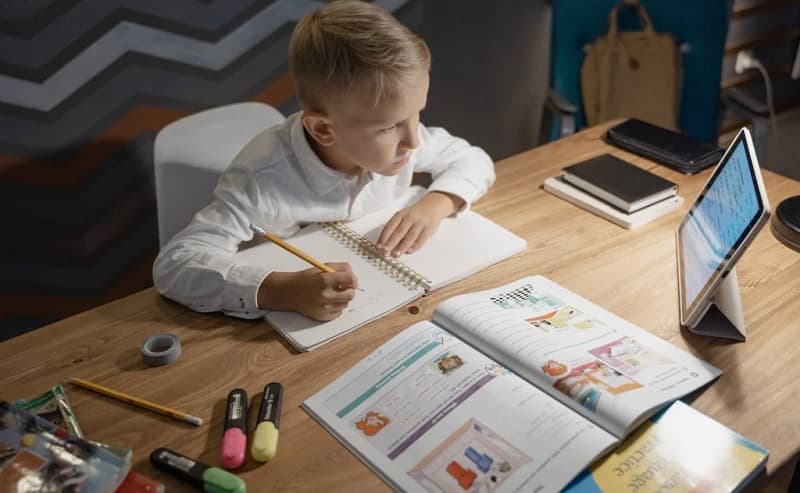Kids are spending more time on their devices, whether tablets, televisions or smartwatches. Has tech overtaken the traditional way they learn and play?
Are kids spending more time with tech?
Technology is so intuitive that even children can use it. Seeing their faces bathed in the glow of a tablet has become so routine that most people don’t question it. Still, has tech overtaken traditional play or does it just seem that way?
Even though it might be noticeable just because this sort of thing didn’t happen a decade ago, screen time is indeed increasing for most kids. One survey asked parents how much time their children spent with tech toys. According to the responses, tablet or computer use went from 68% to 81% in just one year.
While using tech more often doesn’t necessarily mean they’re playing in the traditional way less, it usually takes up most of their lives. For example, adolescents are on their screens for nearly seven and a half hours daily — it seems like it’s their full-time job. They can’t run outside or use their imagination when they spend a whole workweek plus overtime on their devices.
Why is tech taking over?
It might seem harmless to let kids use screens, but it’s overtaken the traditional way they learn and play. Now, hanging out with friends means meeting up in an online game. Why are they spending more time online than ever before?
Tech toys may have started as light-up robots or remote-controlled cars, but it’s progressed to internet-connected dolls and baby-sized smartwatches. Most technology has become much more affordable over the years, so outfitting kids with the latest gadgets makes sense if it keeps them occupied.
The COVID-19 pandemic also caused many families to rely on it. Many couldn’t send their kids to summer camp or schedule playdates, so they were left with educational apps and videos. For example, while only 16.3% of kids spent more than four hours on their phones daily before, it rose to 66.3% during the pandemic.

Do kids need to play the traditional way?
Technology designed for children is usually bright, loud and colorful, so it holds their attention well. Plopping a kid down in front of an educational video is easy and can keep them entertained for hours — but is it good for them? Balanced use can be, but many parents don’t set timers to take away tech for the day.
A lot of screen time isn’t good for kids. Experts recommend that children 18 months old or younger only use tech under adult supervision to communicate with friends or family. Parents should limit those from 18 to 24 months to an hour of screen time daily.
Engaging in activities is much healthier for kids. Too much time in front of a screen can cause lower verbal intelligence, shorter attention spans and altered emotional responses. Their developing minds need stimulation from physical and creative play — something they don’t typically get when they’re on their devices.
Why should parents encourage change?
Although tech for kids can have significant benefits, it’s overtaken traditional learning and play. Parents should encourage change because it’s much healthier. According to most developmental psychologists, kids should play outside and use their imagination to create engaging experiences rather than sitting on screens all day.
Even though handing them a device or plopping them in front of a television is a great way to keep them occupied, better alternatives exist. Parents who want to keep them engaged have many great options for kids’ developing minds and bodies. Summer camps let children meet their learning and developmental needs through hands-on activities. A playground, zoo, museum or park are ideal places to take them.

What are the benefits of traditional learning and play?
While limited technology use can benefit kids, it’s not a great substitute for traditional learning and play. Physical and in-person interactions have plenty of unique benefits.
There are plenty of plusses to playing and learning the traditional way:
- Builds a strong imagination: Children build a strong imagination when using objects around them to create storylines. It lets them be creative.
- Strengthens their bodies: Physical fitness is essential for young children. Running, jumping and crawling also help their fine motor skills and balance.
- Boosts developmental growth: Unstructured activities develop and strengthen essential connections in their brains.
- Encourages problem-solving: Educational tech often presents the answers to kids after a pause. They must rely on their problem-solving skills when they learn traditionally.
- Improves their social skills: Interacting with other kids is a necessary part of growing up. While talking online is similar, they miss out on a face-to-face connection. In-person play lets them learn facial expressions and social cues.
Learning and playing without screens are important for kids. They thrive on fun experiences and grow a lot from exciting activities.
Tech Versus Traditional
Technology has overtaken how kids learn and play. Even though it provides many educational and social opportunities, parents must balance its use — nobody needs to spend an entire workweek in front of a screen.








